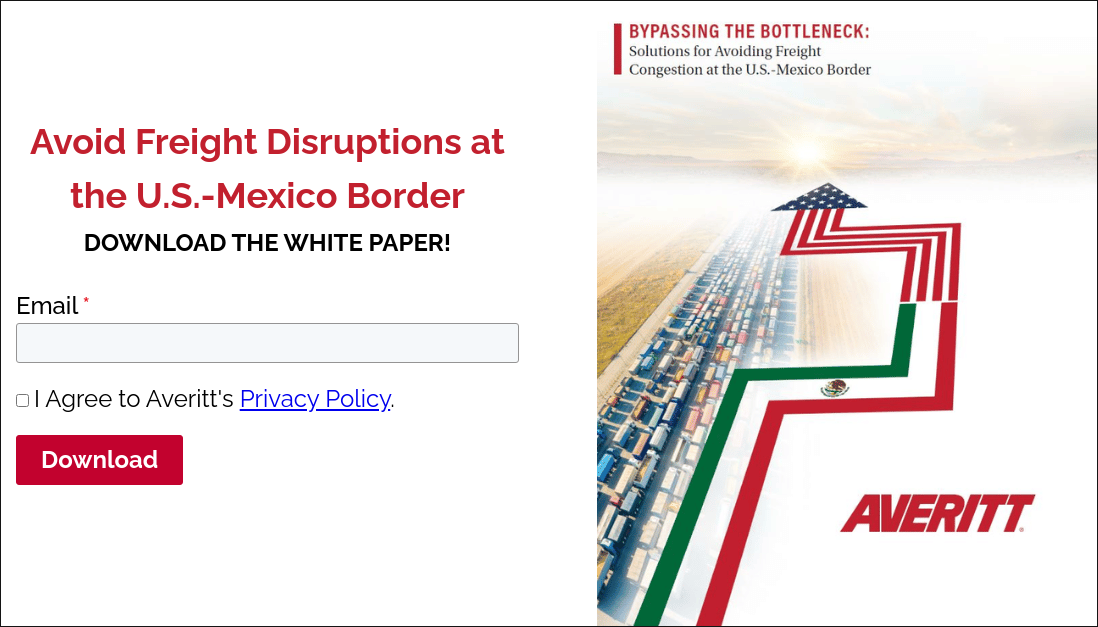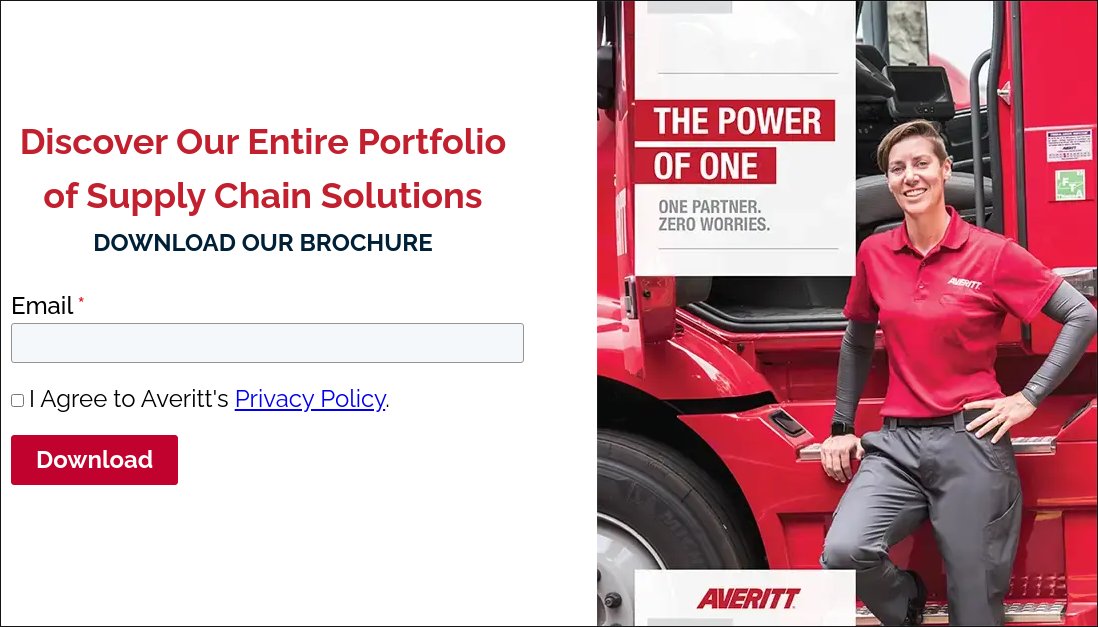The implementation of the United States-Mexico-Canada Agreement (USMCA) in 2020 significantly reshaped economic relationships across North America. This modernized trade agreement replaced the North American Free Trade Agreement (NAFTA) and aimed to facilitate cross-border trade and investment among the three countries.
At the same time, the growing trend of nearshoring, driven by factors such as supply chain resilience, cost optimization, and proximity to major consumer markets, has further accelerated the movement of goods between the United States, Mexico, and Canada.
Watch A Short Video About Our Mexico Services!
What if shipping freight to and from Mexico was as easy as, say, shipping to one of your customers here at home. A quick phone call or a few clicks and you're ready to go. Well now it is. Because when you use the power of Averitt's Mexico Cross-border services, you can count on an experience that's seamless, secure, and flexible to your needs. Whether it's sending raw materials or retail goods into Mexico or receiving Northbound assembly parts or finished products for distribution anywhere in the US and Canada, Averitt has a complete door-to-door solution for your cross-border supply chain needs, that is backed by our total North America transportation network, and when it comes to security, we take all the extra precautions to ensure that your freight is under constant surveillance and in hands, you can trust on both sides of the Rio Grande. You can also forget the hassle of dealing with numerous third parties. Why? Because our bilingual team of Cross-border and USMCA transportation experts can do a lot more than you think. Whether it's LTL, Truckload, Expedited, Intermodal or even Dedicated Fleet Solutions, our in-house customs clearance team will work to ensure that your freight crosses the border without unnecessary delays. We can even secure freight capacity and reliable on-time delivery with one of our carefully selected partner carriers within Mexico, and when it comes to your needs along the border, we'll help save you time and money at one of our cross-border distribution centers with flexible warehousing, cross-docking inventory, management, and pool distribution throughout North America. All with just one call, one invoice, and zero worries because when you ship to or from Mexico with the Power Of One, there are no borders.
This rise in North American trade highlights the critical need for efficient and dependable cross-border services for companies engaging in commerce throughout North America. These businesses must ensure that goods flow freely across borders while adhering to evolving regulations, overcoming language barriers, and securing reliable transportation capacity. Failure to address these challenges can result in costly delays, supply chain disruptions, and lost opportunities.
Averitt has a comprehensive suite of cross-border services that helps streamline these processes, ensuring that your freight reaches its destination on time and fully complies with all necessary regulations. Our extensive experience has given us a deep understanding of each region's unique challenges and requirements. So in this post, we'll examine several common cross-border challenges and how to address them.

Understanding Cross-Border Shipping Challenges
While cross-border shipping allows businesses to expand their reach and tap into new markets, it also comes with several challenges – obstacles that can significantly impact shipping efficiency, reliability, and overall supply chain performance. Some of the most common include:
1.) Customs and Compliance Regulations
Each country has its own set of complex customs regulations, documentation requirements, and compliance standards that must be adhered to. These regulations can vary significantly across borders, covering things like product classification, valuation, country of origin rules, and prohibited or restricted items. Failure to comply can cause serious disruptions in the movement of your freight.
2.) Language Barriers
Effective communication is crucial in cross-border shipping, as it involves coordinating with various stakeholders, including customs clearance, logistics providers, and business partners in different countries. Language barriers can lead to misunderstandings, errors in documentation, and delays in resolving issues.
3.) Capacity and Reliability
Securing reliable transportation capacity and partners is a significant challenge, particularly during periods of high demand. The availability of transportation resources can fluctuate due to factors such as weather conditions, infrastructure constraints, and driver shortages. Businesses must have access to a robust logistics network with multiple transportation modes (LTL, FTL, rail, air, etc.) and strategic partnerships to ensure their goods are delivered on time and without disruptions, regardless of the market conditions.
These challenges, if not addressed effectively, can have a significant impact on shipping efficiency and reliability, leading to delays, increased costs, and potential disruptions to business operations.
Best Practices for Cross-Border Shipping
There are several key practices businesses can adopt to help ensure success in their cross-border shipping. These practices streamline shipping processes and reduce the risks related to international trade compliance and regulations, ensuring smoother and more reliable operations.
Watch A Short Video About Our Canada Services!
For over fifty years, shippers have turned to Averitt when they need the most reliable transportation and logistics services throughout the US. Our professional reputation and dedication to service, however, doesn't just stop at our country's borders. Because when it comes to shipping between the US and Canada, our customers know they can count on Averitt to deliver a worry free and seamless experience no matter which side of the border their freight is heading. That's because we've partnered with the best in class Canadian service providers that share our common vision to ensure that shippers are positioned to succeed at every turn Through our gateway distribution hubs in Chicago, Cincinnati, and Winchester, Virginia, we deliver consistent line haul services that move without fail to and from points across Canada. And through our unique premium ground services, we can help you shave days off back, Averitt delivers a wide range of cross border North America freight solutions, including LTL, truckload, expedited ground and air, intermodal, and even distribution and fulfillment services at secure partner facilities located in major markets throughout Canada. But when it comes to the experience itself of shipping to and from Canada with Averitt, our customers know their freight is always in good hands. Because they have access to all inclusive online LTL rates and twenty four seven shipment monitoring and customer service from our centralized call center in Cookeville, Tennessee, where a helpful voice is always available by phone or email, all backed by the aid of our in house customs clearance and USMCA experts that streamline the entire cross border process. Because at the end of the day, whether it's in the US or Canada, our customers can always count on the simplicity of one call, one invoice, zero worries. That's the power of one.
1.) Navigating Customs and Compliance
Understanding and adhering to customs regulations in each country is crucial for cross-border shipping. Non-compliance with these regulations can result in costly delays, fines, or even the seizure of goods. Averitt offers comprehensive customs clearance services, ensuring that your shipments meet all necessary requirements and documentation for seamless border crossings. This includes:
A.) Accurate and Complete Documentation
Ensuring that all required documentation, such as commercial invoices, packing lists, and certificates of origin, are properly prepared and submitted to customs authorities.
B.) Classification and Valuation
Correctly classifying goods and accurately valuing them for customs purposes to avoid potential penalties or delays.
C.) Compliance with Trade Regulations
Adhering to all relevant trade regulations, such as those related to restricted or prohibited items, to prevent shipment delays or seizures.
Our experienced customs teams work closely with shipping clients to ensure all aspects of customs clearance are handled efficiently, allowing for a smoother, faster shipping process that keeps your supply chain moving without interruption.

2.) Using a Robust Logistics Network
In today’s constantly changing cross-border environment, businesses can't rely solely on their own resources and capabilities. They need to leverage the expertise and resources of trusted logistics partners who have a deep understanding of the intricacies of cross-border shipping and a robust transportation network that spans multiple regions.
A reliable logistics partner with an extensive transportation network can offer businesses access to a wide range of transportation modes and routes, enabling them to optimize their supply chains based on specific shipment requirements, such as time sensitivity, cost considerations, or specialized handling needs.
At Averitt, our infrastructure is specifically designed to meet the demands of North American trade. Our extensive coverage and strategic partnerships ensure your goods reach their destination seamlessly and promptly, regardless of the chosen route or mode of transport. Our relationships with local logistics providers in Canada and Mexico, coupled with our deep understanding of customs clearance procedures, allow us to coordinate operations smoothly on both sides of the border.

3.) Planning for Contingencies
Even with thorough planning and preparation, cross-border shipping can still present unforeseen challenges and disruptions. From customs delays and holds to weather-related incidents, capacity constraints, and unexpected regulatory changes, there are a number of events that can significantly impact shipping schedules and overall supply chain operations.
That’s why effective contingency planning is crucial for minimizing the impact of such disruptions and maintaining reliable delivery commitments. Here are some suggested strategies for minimizing disruptions and maintaining shipping schedules in cross-border operations:
A.) Diversify Transportation Modes and Carriers
Don’t rely solely on one mode of transportation. Diversify your options by utilizing multiple modes (trucking, rail, air). This provides flexibility to shift loads if one mode/carrier experiences delays or disruptions.
B.) Implement Backup Plans
Develop backup plans for rerouting shipments, identifying alternative ports/borders, and securing additional capacity from other providers. Having these contingencies in place allows you to quickly adapt when issues arise.
C.) Maintain Buffer Stock
Consider holding some buffer inventory of critical items/materials closer to end customers or key distribution points. This stock can help mitigate shorter disruptions until primary shipping channels are restored.
D.) Compliance and Documentation Preparedness
Ensure all documentation is complete, accurate, and compliant with the latest regulations. Customs delays are a frequent cause of disruption, so having paperwork in order is critical for smooth border crossings.
E.) Collaborate with Logistics Partners
Work closely with your logistics providers, sharing forecasts and being transparent about contingency needs. Their expertise can identify risks, and they can proactively position resources accordingly.
A diversified and agile cross-border shipping strategy, combined with robust planning, can help businesses minimize the impacts of disruptions and maintain delivery schedules for their customers. Learn more about bypassing border bottlenecks in our recent white paper.

4.) leverage certified partners
While C-TPAT (Customs-Trade Partnership Against Terrorism) and FAST (Free and Secure Trade) certifications are not strictly required for shipping freight across the US-Mexico border, they offer significant advantages for companies involved in cross-border trade. Here’s a detailed overview:
A.) C-TPAT (Customs-Trade Partnership Against Terrorism)
C-TPAT is a voluntary supply chain security program led by U.S. Customs and Border Protection (CBP). It aims to strengthen international supply chains and improve U.S. border security.
1.) Benefits:
- Reduced number of CBP inspections.
- Priority processing for CBP inspections.
- Eligibility to attend C-TPAT training seminars.
- Access to the C-TPAT Status Verification Interface, which allows members to communicate their status to other members.
2.) Impact on Cross-Border Trade:
Participation can expedite the clearance process and reduce delays, making it easier to move freight efficiently across the border.
B.) FAST (Free and Secure Trade)
1.) Purpose:
FAST is a bilateral initiative between the U.S., Canada, and Mexico designed to ensure security and expedite legitimate cross-border trade.
2.) Eligibility:
- Importers must be C-TPAT certified.
- Carriers must be C-TPAT certified.
- Drivers must undergo a background check and be FAST approved.
3.) Benefits:
- Dedicated lanes for faster border crossing.
- Reduced number of inspections.
- Simplified customs procedures.
4.) Impact on Cross-Border Trade:
- Significant reduction in waiting times at the border.
- Streamlined customs clearance processes.
While neither C-TPAT nor FAST certifications are mandatory for cross-border shipping, they provide substantial benefits by enhancing security and efficiency, reducing inspection times, and expediting customs clearance. These certifications can be particularly valuable for businesses looking to improve their supply chain reliability and reduce the risk of delays.
Averitt has C-TPAT and FAST certifications, ensuring our customers can seamlessly move freight across the borders with as much ease as possible.
5.) Understanding and Adapting to Market Dynamics
The cross-border shipping landscape is constantly evolving, influenced by countless factors across the United States, Mexico, and Canada. Political shifts, such as changes in trade agreements, tariff policies, or geopolitical tensions, can have significant impacts on cross-border operations. Economic indicators, such as GDP growth, inflation rates, and consumer confidence, can also greatly influence cross-border shipping volumes and demand patterns.
Regulatory environments are another critical area that businesses must monitor closely. Evolving customs regulations, security protocols, and environmental policies can impact everything from documentation requirements to transportation modes and routing decisions. Failure to adapt to these changing regulations can result in costly delays, fines, or even the seizure of goods.
Staying informed about these changing market conditions is crucial for businesses to develop effective and adaptable shipping strategies that can withstand potential disruptions and capitalize on emerging opportunities. Leveraging industry resources such as FreightWaves, Logistics Management, and Averitt’s own blog can help you keep track of the latest trends and developments affecting cross-border shipping operations.
Solutions for Simplifying Cross-Border Shipping with Averitt
Averitt’s specialized expertise, comprehensive end-to-end service offerings, and customs clearance capabilities provide a competitive advantage for businesses seeking to simplify cross-border shipping operations. With a deep understanding of the unique challenges and requirements of each region, we offer tailored solutions to ensure your goods are transported efficiently, reliably, and in full compliance with all relevant regulations.
Averitt’s Cross-Border Shipping Solutions Include:
Customs Clearance and Compliance Services
Averitt’s dedicated customs clearance team ensures that all documentation and procedures are properly handled, minimizing the risk of costly delays or penalties. This includes accurate classification and valuation of goods, adherence to trade regulations, and smooth border clearance.
End-to-End Transportation Solutions
From North America truckload services and LTL services to intermodal and air freight services, Averitt provides a comprehensive range of transportation solutions tailored to meet the specific needs of cross-border shippers. This includes leveraging a robust network of strategic partnerships and facilities across the U.S., Mexico, and Canada.

Contingency Planning and Risk Management
Averitt’s experienced team works closely with shippers to develop customized contingency plans, ensuring supply chain resilience and the ability to adapt to unforeseen circumstances, such as customs delays, weather-related disruptions, or capacity constraints.
By partnering with Averitt, you gain a trusted ally in navigating the challenges of cross-border shipping. Our solutions are designed to simplify your operations, mitigate risks, and provide the peace of mind that your goods will reach their destinations on time and in full compliance with all regulations.
Take the first step towards streamlining your cross-border supply chain today. Contact us to learn more about our tailored solutions and how we can help your business thrive in the dynamic world of cross-border shipping.








.webp)


